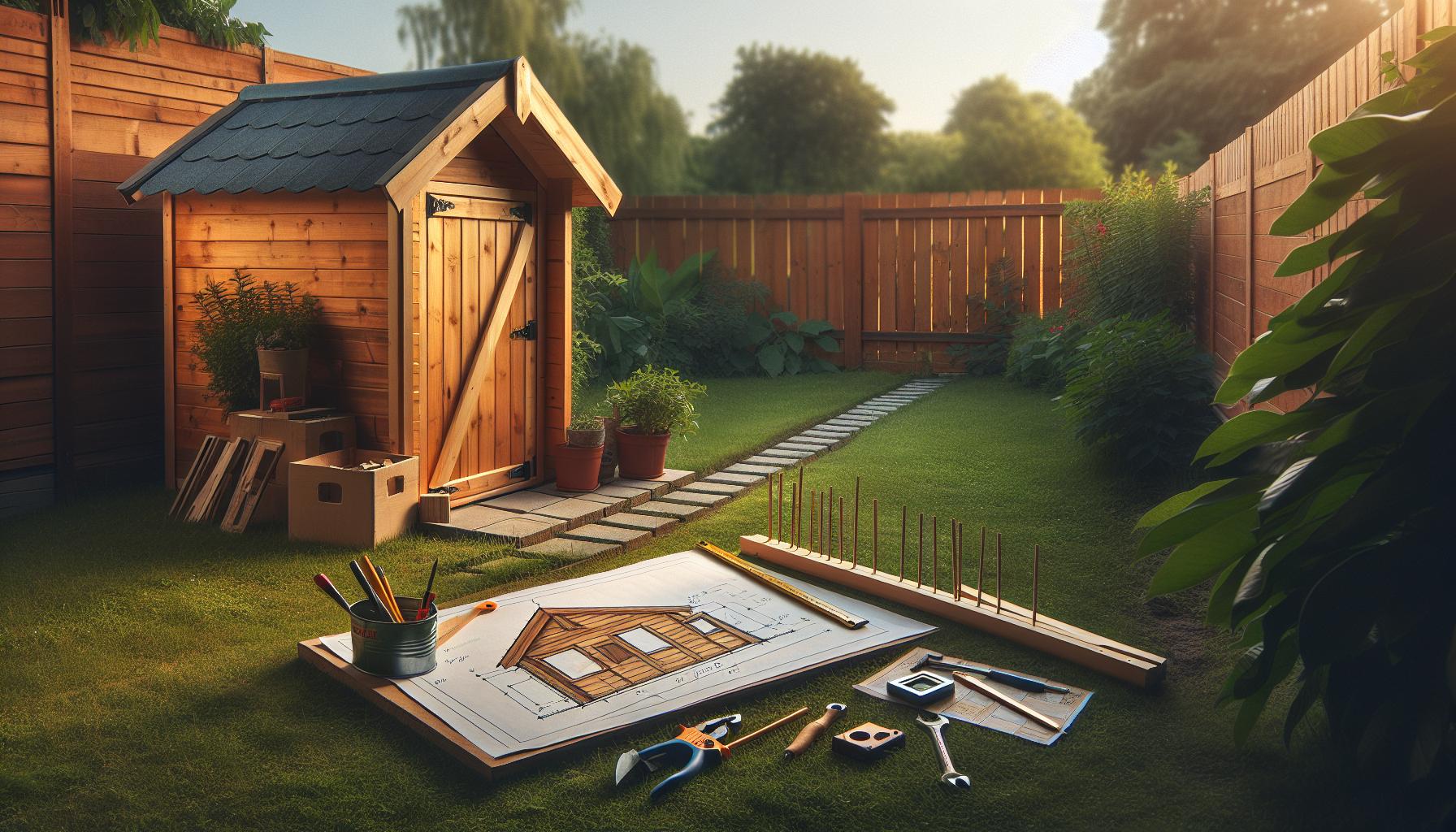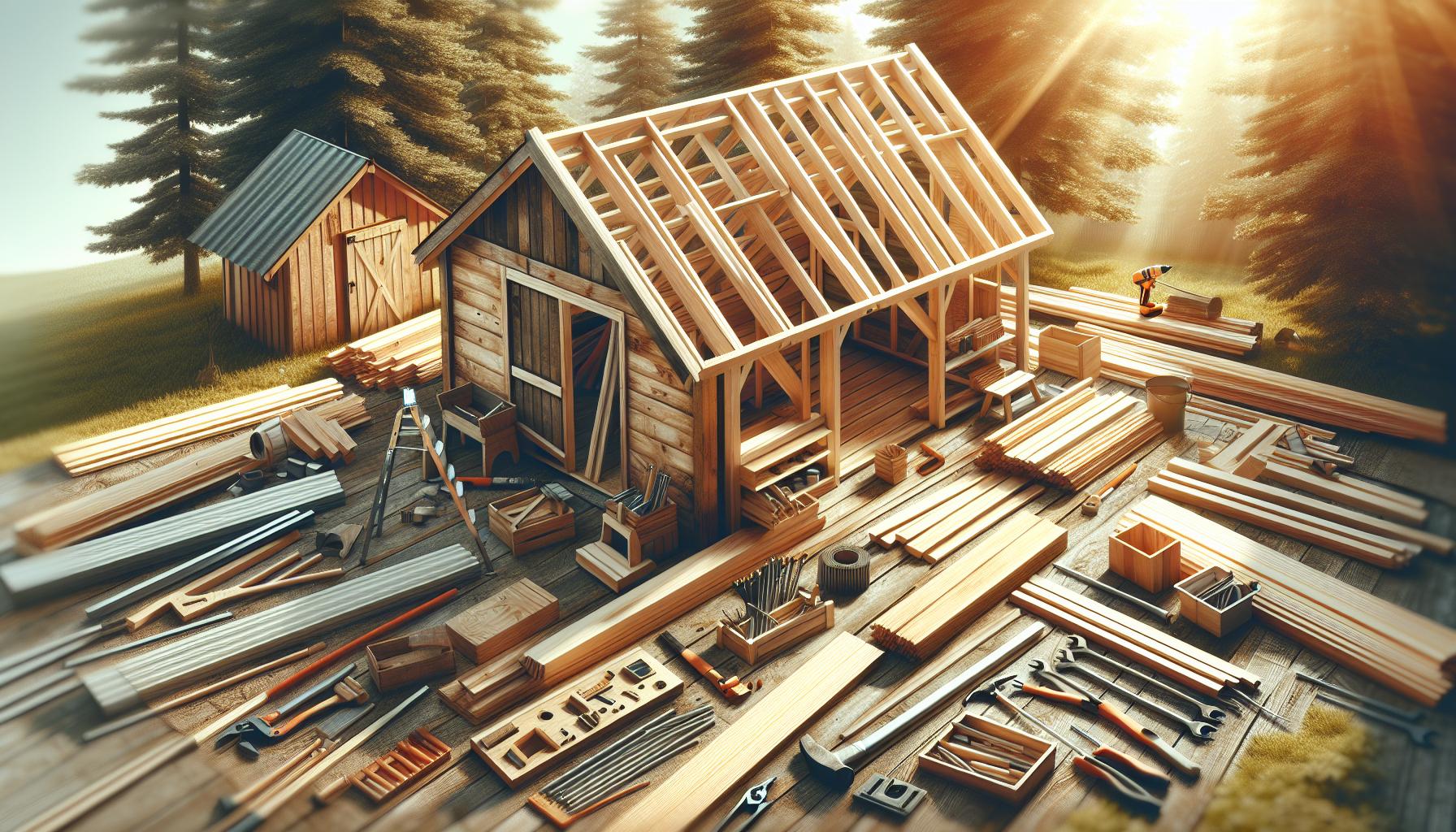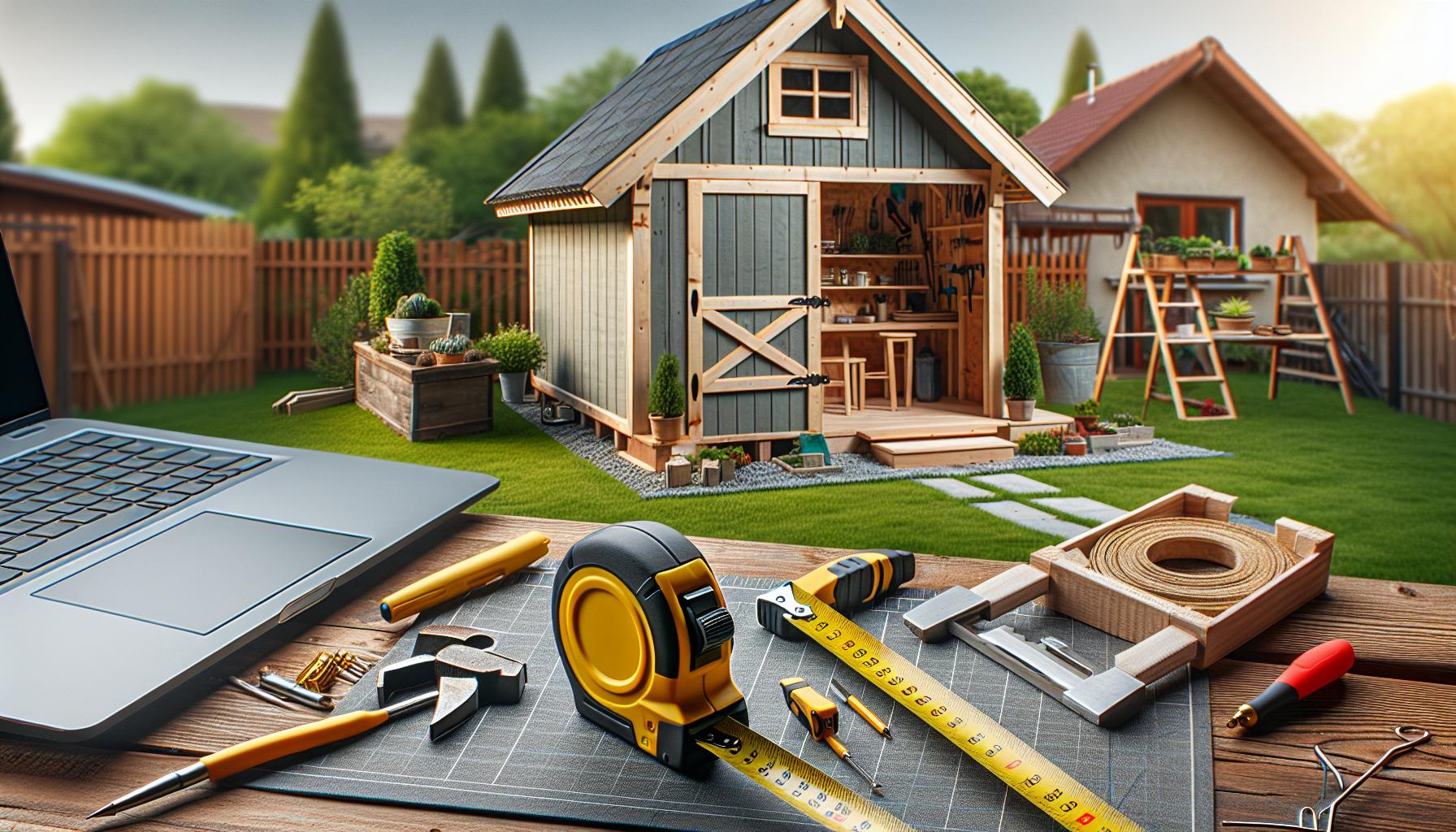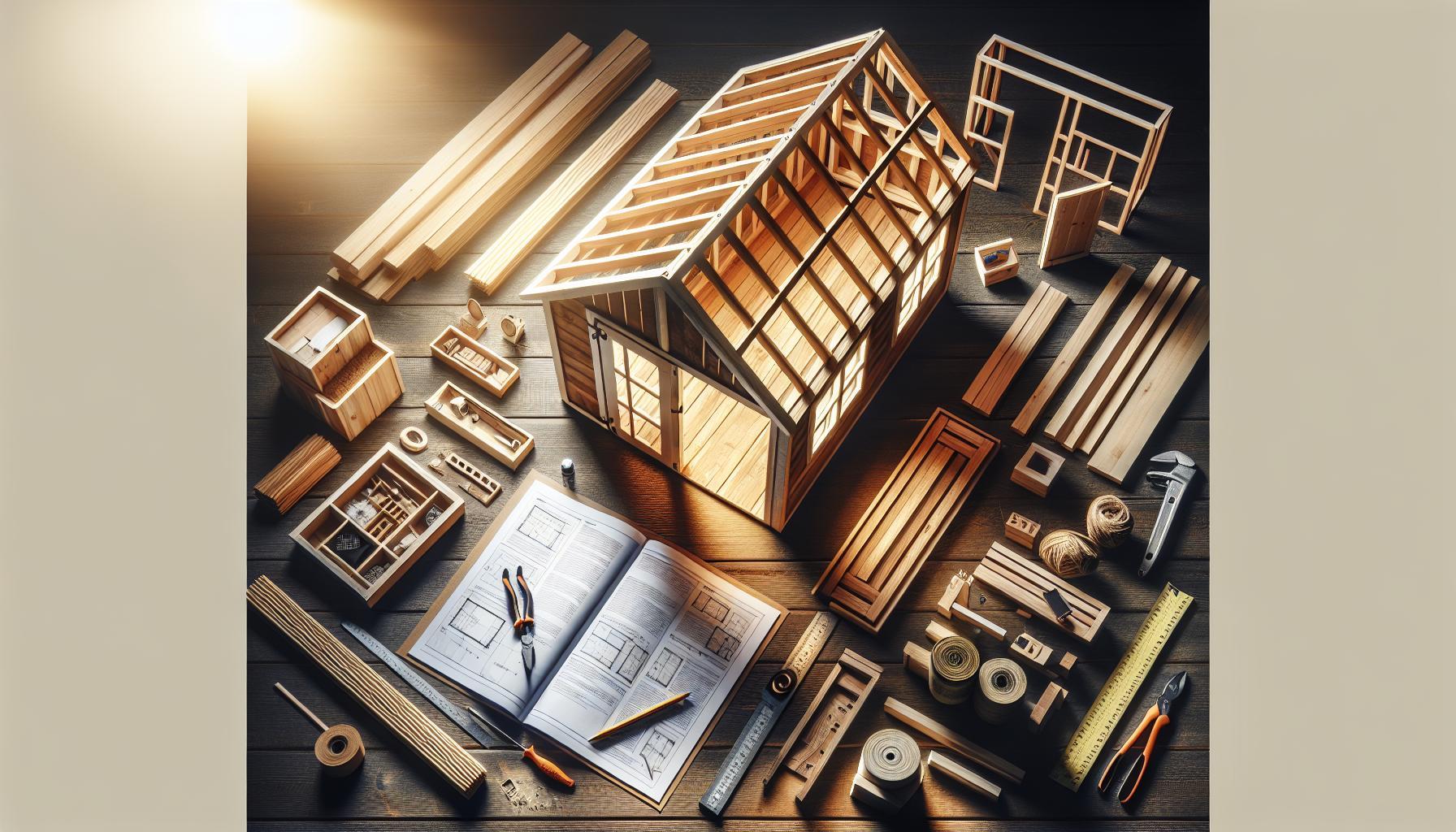Building a shed can boost your property’s functionality, but determining how close you can place it to your property line can be tricky. Understanding legal distance requirements not only prevents potential disputes with neighbors but also ensures compliance with local zoning laws. Let’s explore the essential guidelines for a worry-free backyard addition.
Understanding Local Zoning Laws for Shed Construction
Understanding local zoning laws is crucial when planning any shed construction project, especially when considering how close you can build a shed to the property line. These regulations are designed to manage land use and ensure that structures comply with community standards, preventing potential disputes with neighbors and local authorities. To navigate zoning laws effectively, you often need to delve into specific municipal codes that dictate allowable structures, their sizes, and their positions relative to property boundaries.
Typically, zoning laws will specify setback requirements, which detail how far a structure must sit from property lines. For example, some regions may require a shed to be at least 5 to 10 feet away from the boundary, while others might have different distance criteria based on the type of zoning—residential, commercial, or agricultural. It is indeed essential to check local ordinances to understand these limits, as the penalties for violation can include fines or mandates to relocate the shed.
When investigating the rules surrounding shed placement, consider these key points:
- Local Ordinances: Different municipalities have unique zoning codes, and even neighboring towns may enforce different regulations. Always confirm the specific rules applicable to your area.
- Building Permits: Some locations may require building permits for sheds, especially those over a certain size. Failing to secure the necessary permits could lead to legal issues.
- Neighborhood Associations: If you live in a community governed by a homeowner’s association (HOA),there may be additional restrictions regarding aesthetics and dimensions.
It’s advisable to consult a zoning professional or attorney familiar with local codes if you’re unsure about how close you can build a shed to property lines. They can provide tailored guidance based on your specific location and help you understand the intricacies of the zoning laws that affect your shed project. Ultimately, being informed about zoning laws not only aids in compliance but also fosters good relationships with your neighbors, as early transparency can alleviate potential disputes before they start.
Property Line Essentials: What You Need to Know
Knowing the limits of your property line can make a meaningful difference in your building projects, especially when considering structures like a shed. Whether you’re an avid DIYer or a first-time homeowner,understanding legal distances and zoning regulations is vital to avoid disputes with neighbors and potential fines. The answer to the question of how close you can build a shed to your property line often involves a mix of local laws, property dimensions, and easements.
Key Factors influencing Property Line Distances
When planning to build a shed, various factors can influence how close you can position it to your property boundary. Here are some essential considerations:
- Local zoning Laws: Each municipality has its own set of zoning regulations that dictate the minimum distances required between structures and property lines. It’s crucial to check with your local zoning office or website for specific regulations related to residential buildings.
- property Type: Your property type (residential, commercial, agricultural) may affect the distance you need to maintain from your property line. Residential zones may have more stringent restrictions.
- Easements: Easements are legal permissions to access portions of your property for utility lines or pathways. A shed built too close to an easement can not only lead to disputes but also legal action.
- Homeowners Association (HOA) Guidelines: If you live in a community governed by an HOA, you must adhere to additional rules, which may be stricter than local laws.be sure to consult your HOA documents before beginning any construction.
Understanding Setback Requirements
Setback requirements are specific distances your shed must be from the property line. These may vary dramatically depending on your location. generally, urban areas may enforce stricter setbacks than rural areas. Below is a typical example of setback requirements across various zones:
| Property Zone | Minimum Side Yard Setback | Minimum Rear Yard Setback |
|---|---|---|
| Residential | 5-10 feet | 10-15 feet |
| Commercial | 10-20 feet | 15-25 feet |
| agricultural | 15 feet | 20 feet |
Before you start building, it’s advisable to measure your property line and consider how these distance regulations apply to your planned shed.Always keep in mind the need to preserve neighborly relationships and ensure your new structure complies with all necessary guidelines. Engaging with local authorities before starting construction can save you from costly mistakes or alterations down the line.
Typical Setback Requirements: Finding the Right Distance
In the realm of property development, understanding setback requirements is crucial for anyone considering building a shed, garage, or any other structure. Setbacks help preserve the aesthetics of neighborhoods and ensure adequate space between buildings, allowing for privacy, light, and airflow. They delineate the minimum distance a structure must be set back from property lines,which can vary significantly depending on local zoning laws and regulations. Knowing these distances can prevent costly legal complications and enhance your property’s value.
Common Setback Distances
Typically, the required setbacks will differ according to the type of structure and its location on the property. Here’s a general overview of typical setbacks you might encounter:
| Structure Type | Front Yard Setback | Side Yard Setback | Rear Yard Setback |
|---|---|---|---|
| Residential Shed | 10-20 feet | 5-10 feet | 5-10 feet |
| Garage | 20-30 feet | 5-15 feet | 10-20 feet |
| Accessory Dwelling Unit | 15-25 feet | 10-15 feet | 10-15 feet |
It’s essential to check local zoning ordinances to confirm these distances, as they can change based on your municipality’s specific regulations. Some areas may have peculiar conditions related to environmental concerns or community standards that could affect permitted distances.
Factors Influencing setback Requirements
Setback requirements are influenced by various factors:
- Property Type: Different regulations apply to commercial versus residential properties.
- Local Zoning Laws: Each jurisdiction can impose unique rules depending on land use planning.
- Neighborhood Associations: Homeowners’ associations (HOAs) may have additional restrictions that go beyond municipal regulations.
- Type of Structure: More ample structures typically require larger setbacks.
It’s advisable to consult with your local planning or zoning department to navigate these legal distances effectively. Additionally, understanding how close you can build a shed to your property line not only helps in compliance but also enhances long-term relationships with neighbors, avoiding potential disputes stemming from encroachments or sightline issues.
The Importance of Easements: What They Mean for Your Shed
Understanding easements is crucial for those planning to build a shed, especially regarding maintaining legal distances from property lines.An easement grants a right to use a portion of someone else’s property for a specific purpose,which can directly impact were you can place your shed. If your property shares a boundary with a neighbor who has an easement, it’s essential to know how this legal right influences the usable space on your land.
Types of Easements and Their Implications
There are various types of easements that could affect your shed placement. Some of the most common include:
- Utility Easements: These allow utility companies to access lines and equipment located on your property.Building too close to these easements could restrict access,leading to potential legal issues.
- Access Easements: If a neighbor has an easement for accessing their own property, it may dictate how close your shed can be located to the property line.
- Drainage Easements: Proper drainage is crucial to prevent flooding; these easements ensure that water flows correctly across properties and may limit where structures can be constructed.
When considering how close you can build a shed to property lines, keep in mind the existence of these easements. You could inadvertently violate legal boundaries if you’re unaware of them.To address this, conduct a thorough property review, consulting your land survey and local zoning regulations to verify any easements on your property.
Planning Considerations for Your Shed
When planning your shed’s location, it’s wise to factor in easements along with local building codes. Here are a few practical steps:
- Consult Legal Documents: Make sure to review the easements outlined in your property deed.
- Engage Professionals: Contact a property surveyor or real estate attorney if you’re unsure about the implications of your easements.
- Communicate with neighbors: Open conversations can clarify easement rights and even lead to cooperative solutions regarding shed placement.
Being informed about easements not only aids in compliance with legal distances but also enhances good neighborly relations.In the event that easements conflict with your intended shed location, you may need to adjust your plans to avoid potential disputes.
Navigating HOA Guidelines: Building Beyond the Basics
Understanding the intricacies of Homeowners Association (HOA) guidelines is crucial for anyone considering construction projects like building a shed. These regulations play a vital role in maintaining the aesthetic integrity of neighborhoods and preventing disputes among homeowners. When you’re pondering the question of how close you can build a shed to your property line, it’s essential to navigate not only local building codes but also the particular rules established by your HOA.
### Clarity in HOA Regulations
Local ordinances frequently enough dictate the minimum setbacks from property lines, but HOA regulations may impose additional stipulations on top of these requirements. To ensure compliance,it’s wise to start by reviewing your HOA’s governing documents,which typically include:
- Bylaws
- Architectural Review Committee requirements
- Rules and regulations specific to outbuildings
For example,while your local goverment may permit a shed to sit five feet from the property line,your HOA might require a minimum of ten feet. Involving them early in your planning process can save you time and frustration later.
### Engaging with the Community
Another significant aspect to consider is the potential for community engagement with your HOA. Building trust and maintaining open lines of communication can be beneficial. Many HOAs hold regular meetings that allow homeowners to voice their plans and concerns. Attending these meetings not only keeps you informed but also gives you insight into how similar projects have been approved in the past.
For those who may feel intimidated by the prospect of presenting their plans, consider creating a visual portrayal of your project. This can include simplified architectural drawings or even digital renderings. By presenting your shed project clearly, you provide the committee with the confidence needed to approve your proposal.
### researching Past Approvals
Reviewing past approvals within your community can also offer invaluable insights. Checking with neighbors who have recently built sheds or other outbuildings can provide context regarding what has been accepted by your HOA. Keep an eye out for:
- Distances that were deemed acceptable
- Design features that were highlighted for approval
- Landscaping or external elements that were required or recommended
Understanding these nuances can significantly impact your ability to build a shed close to your property line without violating HOA guidelines.
| Potential Challenges | Solutions |
|---|---|
| Conflicting regulations | Consult both local codes and HOA rules before planning your shed. |
| Approval delays | Submit all necessary documents and attend meetings to expedite the process. |
| Community objections | Engage in conversations with neighbors to address concerns ahead of time. |
In sum,effectively navigating HOA guidelines is not just about adhering to legal distances; it’s about understanding and engaging with your community’s standards and expectations. By taking these steps, you can ensure a smoother journey through the construction process, leading to a finished project that complements your home and neighborhood.
Tips for Measuring Distances Accurately
To effectively build a shed while adhering to property line regulations, accurate distance measurement is crucial. A small mistake in estimating how close you can build a shed to the property line could lead to significant legal and financial ramifications.Here are some practical tips for ensuring your measurements are as accurate as possible.
Use Reliable Tools
To measure accurately, invest in high-quality tools. Here are some essential items you may need:
- Measuring Tape: A long, sturdy measuring tape (at least 100 feet) is indispensable for larger properties.
- Laser Distance Measurer: For high-tech precision, these devices can quickly calculate distances with minimal margin for error.
- String level: This can definitely help you create a straight line between the points you are measuring, ensuring that your distance from the property line is even everywhere.
Know Your property Boundaries
Before you start measuring, it’s essential to know where your property lines are. This can typically be found in your property deed or by using local surveying services. If unsure,consider hiring a land surveyor; their expertise can prevent costly mistakes. Having an updated plat map can also assist in visualizing your lot’s layout.
Double-Check Measurements
To avoid miscalculations, always double-check your measurements.Here’s a simple method to validate:
| Step | Action |
|---|---|
| 1 | Measure from the edge of your structure to the property line. |
| 2 | have a partner measure the same distance from the opposite side. |
| 3 | Compare results; if they match, you’re likely accurate! |
Ensuring accuracy in these measurements not only helps determine how close you can build a shed to the property line but also avoids potential disputes with neighbors or fines from local authorities. remember, a meticulous approach to measuring today can save you headaches tomorrow.
Common Mistakes to avoid When Building Near Property Lines
Building close to property lines can seem like a straightforward task, but many homeowners overlook critical regulations and best practices that can lead to costly mistakes. When navigating the complexities of local zoning laws and property regulations, it’s vital to understand not just what you can do, but what pitfalls to avoid. Recognizing these common missteps can save you time, money, and potential legal troubles down the line.
Misjudging Setback Requirements
One of the most frequent errors homeowners encounter is misjudging the required setbacks, which are the minimum distances that structures must be from property lines. Local regulations vary widely, but here are some things to keep in mind:
- Research Local Zoning Codes: Always check your municipality’s zoning codes as these dictate how close you can build to property lines. Online resources or a quick visit to your local city hall can provide this crucial facts.
- Consult Professionals: If you’re unsure about local regulations, hiring a land surveyor or a builder experienced in local laws can prevent accidental violations.
Ignoring Neighbor Relations
While not a legal requirement, good neighbor relations can significantly impact the enjoyment of your property. Ignoring the opinions of neighboring property owners can lead to disputes and even legal challenges. Remember to:
- Communicate early: Discuss your building plans with neighbors as early as possible. This can help address any concerns they may have and could save you from future disputes.
- Consider Aesthetics and Functionality: Ensure your shed doesn’t obstruct your neighbor’s view or sunlight, as this can lead to resentment even if legally permissible.
Overbuilding Without Permits
One of the biggest pitfalls is starting construction without obtaining the necessary permits. not only can this lead to fines, but unpermitted structures may also be required to be demolished. To avoid this:
- Always Obtain the Proper Permits: Before beginning construction, check with your local building authority to see what permits are required.
- Keep Documentation Handy: Store all your permits and plans in an easily accessible location. this will help when verifying compliance with local regulations.
By being mindful of these common missteps when considering how close you can build a shed to property lines,you can navigate the legal landscape effectively,maintaining not only compliance but peace of mind as well.
Seeking Professional Help: when to Consult an Expert
When considering the construction of a shed, understanding the legal distances from property lines is crucial. Building too close can lead to disputes with neighbors or even legal penalties. This guide emphasizes the importance of consulting local regulations and examining your property’s zoning laws to ensure that your shed is positioned correctly.
Understanding Local Regulations
Local regulations can vary greatly depending on your municipality. Many areas have specific guidelines regarding the minimum distance required between your structure and the property line. For example, some places may require at least 5 feet of clearance, while others could mandate up to 10 feet or more. Before starting your project, it’s advisable to:
- Check with your local zoning office.
- Review any homeowners’ association (HOA) rules if applicable.
- Consider geographical factors that might affect setbacks, like slopes or easements.
Consulting with an Expert
In certain circumstances, it might potentially be beneficial to employ a professional, such as a land surveyor or an attorney, especially when clarity on property boundaries is critical. These professionals can provide valuable insights:
- Land Surveyors: They can accurately measure your property lines and ensure that your shed complies with local laws.
- Zoning Officials: They can clarify any ambiguous regulations you might encounter during your planning phase.
- Legal Advisors: If disputes arise, a legal expert can guide you on how to resolve them amicably or represent your interests effectively.
Remember, the investment in professional help can save you time and money in the long run by preventing costly mistakes that could arise from improper building practices or legal issues.
By understanding the factors that dictate legal distances and knowing when to seek expert consultation, you can ensure a smoother construction process for your shed. Be proactive; research your local guidelines and consult with professionals when uncertainty arises—doing so will protect your investment and maintain good relations with your neighbors.
Faq
How Close Can I Build a Shed to Property Line?
The distance you can build a shed from your property line varies by locality, but it generally ranges from 3 to 10 feet. Always check your local zoning laws or homeowners association (HOA) rules for specific requirements.
Before you start your project,it’s crucial to understand local regulations,as they can significantly differ by municipality. For example, cities might have strict zoning laws that require at least 5 feet from the property line, while rural areas may have more flexibility. Consult with your local planning office or zoning guide for detailed information.
What is a Setback Requirement?
A setback requirement is a minimum distance from the property line within which you cannot build structures like sheds. These distances are established to ensure privacy and safety in residential areas.
Setback requirements can vary not just by locality but also by the type of structure being built. As an example, a larger shed may require a greater setback compared to a smaller garden shed. Understanding these requirements is essential to avoid potential fines or being forced to move your shed after it has been constructed.
can I Build a Shed Without a Permit?
In many cases,you can build a shed without a permit if it meets specific size limitations,typically under 120 square feet. Though, this varies widely, so check local regulations.
Even if you can build without a permit, it’s essential to abide by setback requirements and any HOA guidelines. Failing to do so can result in penalties or orders to dismantle your shed. Always verify whether your project needs a permit to ensure compliance and peace of mind.
Why Do Setback Distances Matter?
Setback distances matter to prevent disputes with neighbors and to maintain orderly development within communities. they also protect against issues like flooding and provide space for future landscaping.
Respecting these distances can enhance community relationships and avoid legal conflicts. Additionally, certain environmentally sensitive areas may have stricter guidelines, so it’s important to be aware of your local landscape and regulations.
What happens If I Build My Shed Too Close to the Property Line?
If you build your shed too close to the property line, you may face legal consequences such as fines, removal orders, or even lawsuits from neighbors. This can lead to significant stress and financial strain.
It’s always better to be proactive—measure carefully and follow local regulations to avoid these pitfalls. Documenting your shed’s location with proper surveys can also provide peace of mind. If in doubt, consult with a professional for guidance.
can My Neighbor Object to My Shed?
Yes, your neighbor can object to your shed if it violates local property laws or impacts their property negatively, such as blocking views or light. Building according to regulations minimizes these concerns.
Maintaining good communication with neighbors during your project can definitely help mitigate objections. Sharing your plans and ensuring your shed adheres to local regulations increases the likelihood of a cooperative atmosphere.
How Do I Determine My Property Line?
To determine your property line accurately, you can consult your property deed, hire a surveyor, or use online mapping tools. Knowing your boundaries is critical before starting any construction.
Property lines are often marked with stakes or fences, but it’s best to rely on official documents. If disputes arise regarding boundaries with neighbors, having a professional survey performed can provide clarity and prevent future conflicts.
What Resources Are Available for Shed Construction Regulations?
Numerous resources are available, including local zoning offices, homeowners associations, and online guides. Always refer to these resources for specific advice tailored to your area.
Utilizing online platforms, such as your local government website or DIY construction forums, can also provide a wealth of knowledge on regulations and best practices. Being informed empowers you to complete your shed project successfully.
In Retrospect
Constructing a shed can be an exciting DIY project, but understanding the legalities of placement in relation to your property line is paramount. Throughout this guide, we’ve unpacked the essential distance requirements that vary by location, helping you navigate local zoning laws, building codes, and property regulations with ease. whether it’s the typical setback distances or the nuances of easements,these considerations are crucial in ensuring a smooth construction process without the headache of legal repercussions.
Remember, checking in with your local planning department can provide clarity and peace of mind, ensuring you’re building responsibly and within the guidelines set for your area. Embrace the collaborative spirit of our DIY community—share your plans, seek advice, and don’t hesitate to reach out when you face challenges. Quality craftsmanship starts with a solid understanding of the rules, but it flourishes in the creativity and dedication you bring to your project.
as you embark on your shed-building journey, keep this guide handy and revisit the key points as needed. The joy of construction awaits, so gather your tools and get ready to create a structure that not only enhances your property but also reflects your personal style. Happy building, and may your shed be the perfect reflection of your hard work and ingenuity!







